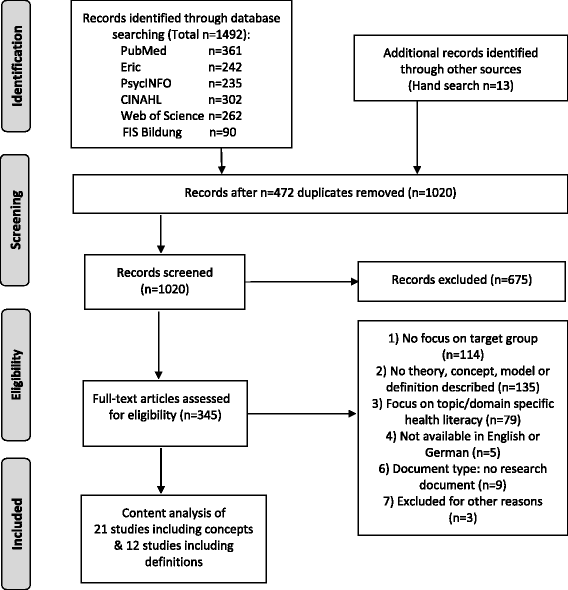Health literacy in childhood and youth: a systematic review of definitions and models
- PMID: 28441934
- PMCID: PMC5405535
- DOI: 10.1186/s12889-017-4267-y
Health literacy in childhood and youth: a systematic review of definitions and models
Erratum in
-
Erratum to: Health literacy in childhood and youth: a systematic review of definitions and models.BMC Public Health. 2017 May 9;17(1):419. doi: 10.1186/s12889-017-4365-x. BMC Public Health. 2017. PMID: 28486939 Free PMC article. No abstract available.
Abstract
Background: Children and young people constitute a core target group for health literacy research and practice: during childhood and youth, fundamental cognitive, physical and emotional development processes take place and health-related behaviours and skills develop. However, there is limited knowledge and academic consensus regarding the abilities and knowledge a child or young person should possess for making sound health decisions. The research presented in this review addresses this gap by providing an overview and synthesis of current understandings of health literacy in childhood and youth. Furthermore, the authors aim to understand to what extent available models capture the unique needs and characteristics of children and young people.
Method: Six databases were systematically searched with relevant search terms in English and German. Of the n = 1492 publications identified, N = 1021 entered the abstract screening and N = 340 full-texts were screened for eligibility. A total of 30 articles, which defined or conceptualized generic health literacy for a target population of 18 years or younger, were selected for a four-step inductive content analysis.
Results: The systematic review of the literature identified 12 definitions and 21 models that have been specifically developed for children and young people. In the literature, health literacy in children and young people is described as comprising variable sets of key dimensions, each appearing as a cluster of related abilities, skills, commitments, and knowledge that enable a person to approach health information competently and effectively and to derive at health-promoting decisions and actions.
Discussion: Identified definitions and models are very heterogeneous, depicting health literacy as multidimensional, complex construct. Moreover, health literacy is conceptualized as an action competence, with a strong focus on personal attributes, while also recognising its interrelatedness with social and contextual determinants. Life phase specificities are mainly considered from a cognitive and developmental perspective, leaving children's and young people's specific needs, vulnerabilities, and social structures poorly incorporated within most models. While a critical number of definitions and models were identified for youth or secondary school students, similar findings are lacking for children under the age of ten or within a primary school context.
Keywords: Adolescents; Children; Conceptual Models; Definitions; Dimensions; Health Competencies; Health Literacy; Literature Review; Pupils; Young People.
Figures
References
-
- Irwin L, Siddiqi A, Hertzman C. Early child development: a powerful equalizer.: Final report for the World Health Organization’s Commission on social determinants of health. Vancouver: University of British Columbia; 2007.
Publication types
MeSH terms
LinkOut - more resources
Full Text Sources
Other Literature Sources
Medical
Miscellaneous


